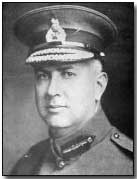
General Arthur Currie
After 3 years of carnage, where the life-blood of entire generations from four continents was left in the soil of Europe, someone on the front lines was given real power to realize a plan that hopefully would see the Allies out of four years of senseless death. That person was Canadian General Arthur Currie and his plan was one the first sign of no front warfare.
(with help from: senior commander, Field marshal, Douglas Haig and Field Marshal Third Army, Julian Byng. It is important to note that after this battle Currie took over Byng's job, as Byng was shuffled up the ladder of success. Currie was the first Canadian Commander of the Canadian Corps.)
Curries plan was the logical progression of the ever increasing complexity of modern war but most inportantly a recognition of how artillary and machine gun had forced tactics to change.
'The Pimple' is the name given to the high ground upon which the German artillery dominants the great plain around Passchendaele just beyond Ypres. Hill 145, just to south, and in range of the Pimple, must be taken at the same time.
The soldiers who would be going over the top were informed of the details of the attsck and trained for weeks. On actual sized layouts of enemy positions, drawn on the ground from maps drawn by special forces and aircraft photography. A new tactic soildiers really liked, was going over the top in small lines, in sections, rather than as a line to be cut down like wheat to a silth of machine gun fire. They trained to walk slowly at an even pace under fire. For as they walked out into no mans land the morning of the attack, behind them, the guns would be sounding and in front of them a curtain of death,artillery, softening up the enemy and cutting. The Canadians were to walk calmly into this hell pacing like the zombees in 'Night of the Living Dead'.
By the end of the day, special forces on both hills are successful - but with horrendous loses (compaired with modern tactics) - and Canadians hold both hills. The fast pre-planned advance through the centre begins. Now the giant machine, Nye a CITY, the size of present day Vancouver, lurches to life, a collasal juergauraut. Forward, to exploit the opening, it moves 4.5 miles the first day, the largest single advance by either side since the first summer, 1914.
It was a template of war to come; at the end of this war, that was to ended by mutual exhaustion, rather than by victory by an army.
Currie created a mammoth information gathering and dissemination system, and supply infrastructure that looked like a modern government bureaucracy. Planners integrated real-time statistical information into battle plan. Like a coiled steel snake about to strike, it was designed to move quickly and powerfully in a synchronised fashion. It was designed not only to win battles but exploit them with powerful, rapid advances. This was one of the first successful examples of what later became known as Combined Operations.
Currie probably borrowed from Field Marshal Alfred Graf von Schlieffen; who's battle plan was the opening act of this war. More importantly I think, is Currie's first hand knowledge of the effects of artillery and machine guns on soldiers that was key to his success.
One of the flanks in this battle, we remember as Flanders Fields. It's where the beautiful poem comes from, from where the Remembrance Day Poppies come from. It was the first battle in the First World War where the Lines moved Miles rather than Yards. It was the beginning of the next wars; Blitzkrieg, Asymmetric warfare, Combined Operations.
No credit to the Canadian Military hierarchy, they buried Currie after the war. Thankfully we re-learned his lessons in time to contribute in the victory over Fascist Germany, in the second go around, called WWII.
If your a soldier in the Canadian Forces now, this should be required reading.
Links:
For King And Empire -a Great documentary, great web site, great maps!
Canadian Government Archives: War Diaries -original sources!
The Changing Face of War: Into the Fourth Generation - West Points leading edge theory
( http://www.censol.ca/research/greatwar/links.htm )
mh



No comments:
Post a Comment